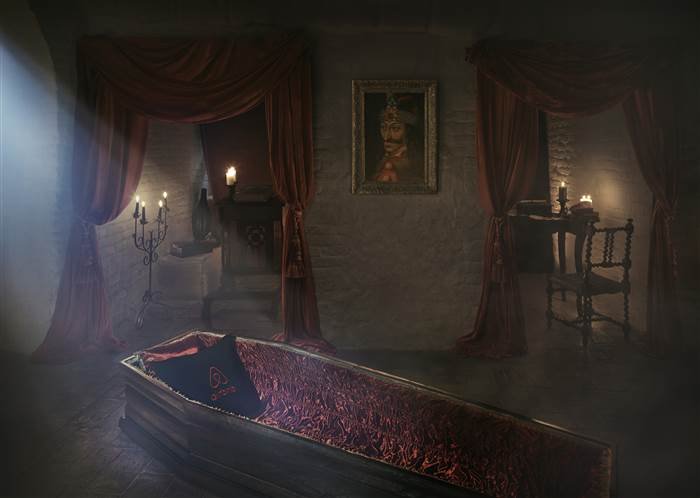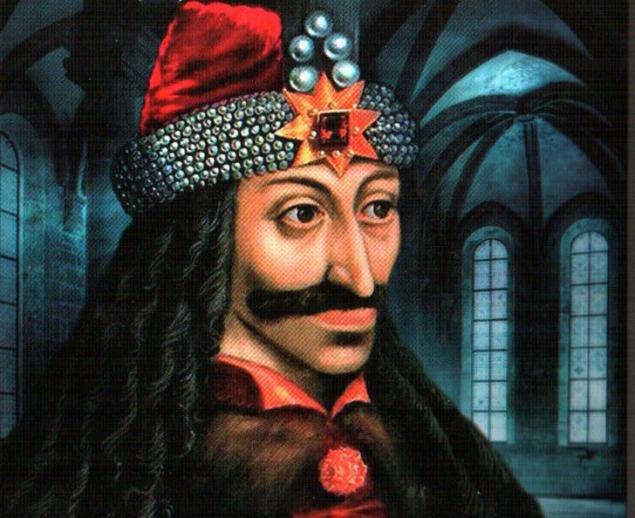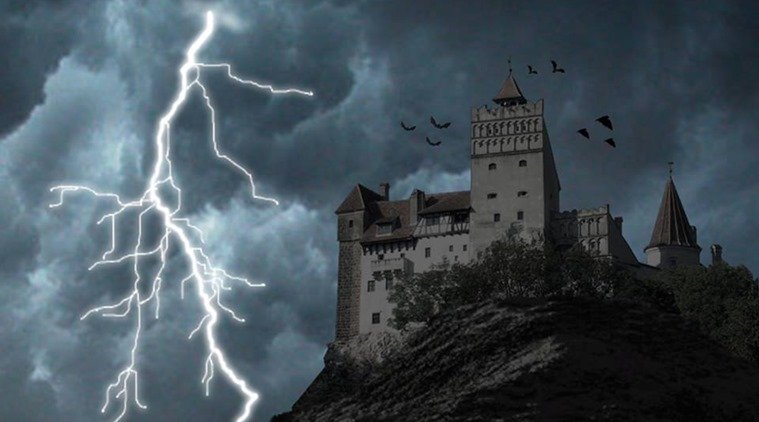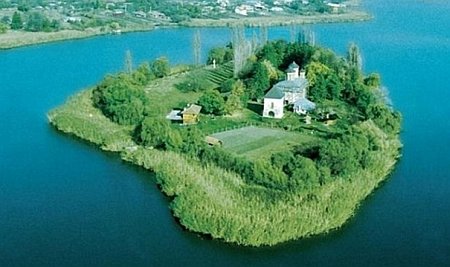"We Draculs have a right to be proud… I am the last of my kind" – Dracula, from Bram Stoker's Dracula
Dracula (Vlad Tepes, Vlad Dracul)Some say that Transylvania sits on one of Earth's strongest magnetic fields and its people have extra-sensory perception. Vampires are believed to hang around crossroads on St. George's Day, April 23, and the eve of St. Andrew, November 29. The area is also home to Bram Stoker's Dracula, and it's easy to get caught up in the tale while driving along winding roads through dense, dark, ancient forests and over mountain passes.
Dracula is literally translated in Gaelic as Drac Ullah meaning bad blood.
Tales of the supernatural had been circulating in Romanian folklore for centuries when Irish writer Bram Stoker picked up the thread and spun it into a golden tale of ghoulishness that has never been out of print since its first publication in 1897. To research his immortal tale, Stoker immersed himself in the history, lore and legends of Transylvania, which he called a "whirlpool for the imagination."
Bram Stoker's Dracula novel was published in Romanian for the first time in 1990.
Count Dracula, a fictional character in the Dracula novel, was inspired by one of the best-known figures of Romanian history, Vlad Dracula, nicknamed Vlad Tepes (Vlad the Impaler), who was the ruler of Walachia at various times from 1456-1462. Born in 1431 in Sighisoara, he resided all his adult life in Walachia, except for periods of imprisonment at Pest and Visegrad (in Hungary). For more information about Bram Stocker's Dracula Novel please visit www.literature.org/authors/stoker-bram/dracula/
 : "In the Footsteps of Dracula."
: "In the Footsteps of Dracula."
Although he never traveled to Romania, Stoker crammed his book with descriptions of many real locations that can still be visited in present-day Romania. They include Sighisoarathe most important historical places associated with Vlad Tepes, such as the 14th century town of Sighisoara where you can visit the house in which Vlad was born (now hosting a restaurant and a small museum of medieval weapons).
Other Dracula sites include: the Old Princely Court (Palatul Curtea Veche) in Bucharest, Snagov Monastery, where, according to legend, Vlad's remains were buried; the ruins of the Poenari Fortress (considered to be the authentic Dracula's Castle); the village of Arefu where Dracula legends are still told, the city of Brasov where Vlad led raids against the Saxons merchants, and, of course, Bran Castle.
A Halloween Themed Infographic
Some tours also cover the folkloric aspects of the fictional Dracula. For instance, visitors can eat the exact meal Jonathan Harker ate at The Golden Crown in Bistrita and sleep at Castle Dracula Hotel, built no so long ago on the Borgo Pass at the approximate site of the fictional Count's castle.
Places to explore
Brasov

Bucharest (Old Princely Court)
Snagov Monastery
Targoviste
Poenari Fortress
Arefu Village
Bran (Dracula's) Castle
Sighisoara
Bistrita (Borgo Pass)
Bucharest
Known for its wide, tree-lined boulevards, glorious Belle Époque buildings and a reputation for the high life (which in the 1900s earned its nickname of "Little Paris"), Bucharest, Romania's largest city and capital, is today a bustling metropolis. Bucharest is laden with historical charm – from the streets of the Old City Center, which are slowly being restored, to the grand architecture of the Royal Palace and the lush green of Cismigiu Park. The city also claims a large number of museums, art galleries, exquisite Orthodox churches and unique architectural sites (find out more about Bucharest).
Old Princely Court (Palatul Curtea Veche)
Address: Strada Franceza 25-31
Telephone: 021 314.03.75
Museum open: Tue. – Sun. 10:00 a.m. – 6:00 p.m.; Closed Mon.
Admission charge
Bucharest - Curtea Veche - Old Princely CourtAt the center of the historic area in Bucharest are the remains of the Old Princely Court, built in the 15th century by Vlad Tepes. According to local lore, Vlad kept his prisoners in dungeons which commenced beneath the Old Princely Court and extended under the city. All that remains today are a few walls, arches, tombstones and a Corinthian column.
The Old Court Museum was established in 1972 when an archaeological dig revealed the remains of the fortress, along with Dacian pottery and Roman coins, evidence of Bucharest's earliest inhabitants. The oldest document attesting to the city's origin under the name of Bucuresti was discovered here. It was issued on September 20, 1459 and signed by Prince Vlad Tepes.
Next to the palace stands the Old Court Church (Biserica Curtea Veche), dating from 1559 and considered the oldest in Bucharest. For two centuries, the church served as coronation ground for Romanian princes. Some of the original 16th century frescoes have been preserved.
Snagov Monastery
Where: 25 miles north of Bucharest
Nearest train station: Bucuresti Nord
Nearest bus stop: Snagov / Silistea Snagovului
In 1458 - more than one hundred years after the church was built (1364) - Romanian prince Vlad Tepes (Vlad the Impaler) added thick defending walls and a dungeon. A plaque on the floor inside the church marks the grave with the presumed remains of the world-known count.
The monastery is located on an island on lake Snagov, and can be accessed on a pedestrian bridge or by boat.
Targoviste – Princely Court (Curtea Domneasca)
Targoviste - Princely CourtWhere: 64 miles northwest of Bucharest
Nearest train station: Targoviste
Address: Calea Domneasca 181
Telephone: 0245 613.946
Open: Tue. – Sun. 9:00 a.m. – 7 p.m.; Closed Mon.
Admission fee
www.CurteaDomneascaTargoviste.ro/
In Targoviste, tour the 14th century Princely Court and Chindiei Watchtower (Turnul Chindiei). The Princely Court served as the capital of Walachia, where Vlad ruled. It was here that the Prince impaled a great many disloyal court members (the boyars) after inviting them to a celebratory feast. Chindiei Watchtower now houses an exhibition illustrating Vlad's life.
Poenari Fortress (Cetatea Poenari)

Location: Valachia – Southern-Centre Romania
Where: 108 miles northwest of Bucharest
Nearby large town: Curtea de Arges (15 miles north)
Nearest train station: Curtea de Arges
Nearest bus stop: Arefu
Web: www.CetateaLuiVladTepes.ro
Open: Mon. - Sun. 9:00 am - 6:00 pm (summer time)
Admission charge: adults 5 lei ($1.75)
The ruins of Poienari Fortress stand high on a cliff overlooking the Arges River, at the foothills of the Carpathian Mountains. Built at the beginning of the 13th century by the first Walachian rulers, the castle changed names and residents a few times over the decades; eventually, it was abandoned and left in ruins.
Poenari Fortress (Cetatea Poenari)Vlad recognized the potential of the location and upon taking over the throne, he ordered that the structure be repaired and consolidated, turning it into one of his main fortresses. When the Turks attacked and captured the castle in 1462, Vlad escaped via a secret passageway leading north through the mountains. Although the castle was used for many years after Vlad's death in 1476, it was eventually abandoned again in the first half of the 16th century and left to the ravages of time and weather. In 1888, a major landslide brought down a portion of the castle which crashed into the river far below. The castle underwent repairs and the remnants of its walls and towers stand to this day.

You will need stamina to climb the 1,462 steps to reach the castle ruins, perched high above the surrounding area like an eagle's nest.
Arefu

Where: 104 miles northwest of Bucharest / 11 miles north of Curtea de Arges
Note: access by car only
Next visit Arefu, where many of the villagers trace their ancestry back to the loyal minions of Vlad Tepes himself (in the movies, these are the ones who are always busy loading up Dracula's coffins with Transylvanian earth). Legend has it that when the Turks attacked and took over the Poenari Castle in 1462, it was the villagers of Arefu who helped Vlad escape. Spend the night with the locals camping around a fire and listening to centuries-old folk tales. Homestays and B&Bs are available in Arefu and nearby villages.
Brasov
Where: 100 north of Bucharest
Nearest train station: Brasov
Bran - Dracula's CastleFringed by the peaks of the Southern Carpathian Mountains and resplendent with gothic, baroque and renaissance architecture, as well as a wealth of historical attractions, Brasov is one of the most visited places in Romania.
(find out more about Brasov)
Founded by Teutonic Knights in 1211 on an ancient Dacian site and settled by the Saxons as one of their seven walled citadels*, Brasov exudes a distinct medieval ambiance and has been used as a backdrop in many recent period films.
Bran Castle
Where: 84 miles north of Bucharest / 16 miles southwest of Brasov
Access: car, train to Brasov, and bus from Brasov to Bran
www.RomaniaTourism.com/Castles-Fortresses.html#Bran
Sighisoara
Where: 170 northwest of Bucharest
Nearest train station: Sighisoara
SighisoaraFounded by Transylvanian Saxons during the 12th century, Sighisoara still stands as one of the most beautiful and best-preserved medieval towns in Europe. Designated as a World Heritage Site by UNESCO, this perfectly intact 16th century gem with nine towers, cobbled streets, burgher houses and ornate churches rivals the historic streets of Old Prague or Vienna for atmospheric magic. It is the birthplace of Vlad Tepes (Vlad the Impaler), ruler of the province of Walachia from 1456 to 1462
(find out more about Sighisoara).
Vlad Dracul's House (Casa Dracula)
Address: Str. Cositorarilor 5
Tel: 0265 771.108
Open: Tue. – Sun. 10:00 a.m. – 3:30 p.m.; Closed Mon.
The Vlad Dracul House is located in Sighisoara's Citadel Square, close to the Clock Tower. This ocher-colored house is the place where Vlad Tepes, the inspiration for Bram Stoker's famous Dracula, was born in 1431 and lived with his father, Vlad Dracul (read more about the story of the Dracul name), until 1435 when they moved to Targoviste. A wrought-iron dragon hangs above the entrance. The ground floor of the house serves as a restaurant, while the first floor is home to the Museum of Weapons.
Bistrita
Where: 265 miles northwest of Bucharest
Nearest train station: Bistrita
Located at the foot of the Bargau Mountains, not far from the Borgo Pass (Pasul Tihuta in Romanian) which connects the provinces of Transylvania and Moldavia, the town of Bistrita is one of the oldest in the region. Archeological findings indicate that the area has been inhabited since the Neolithic age, long before Bram Stocker chose it as the setting of his fictional Dracula's castle.
In Bram Stoker's novel, Dracula, a young Englishman, Jonathan Harker, visits Bistrita and spends a night at the Golden Krone Hotel (Hotelul Coroana de Aur) on the eve of St. George's Day before continuing his journey east to Count Dracula's castle. Although no such hotel existed when the novel was written, a hotel with the same name has since been constructed for visitors.
Saxon colonists, who settled here in 1206, helped develop the town into a flourishing medieval trading post. First mentioned in 1264 as Villa Bistiche, the name was later changed to Civitas Bysterce. Soon enough, Bistritz, as it was known to its German inhabitants, became one of Transylvania's most important Saxon citadels (Siebenbürgens*).
Today, the old town's quaint 15th and 16th century merchants' houses, the remains of the 13th century fortress walls and a generally unhurried pace have preserved some of Bistrita's medieval atmosphere (find out more about Bistrita).
Borgo Pass (Pasul Tihuta)
Where: 277 miles northwest of Bucharest / 12 miles northeast of Bistrita
Note: Access by car only
Borgo Pass (Bargau in Romanian), made famous in the opening chapter of Bram Stoker's Dracula, is an oft-trod passageway through the Carpathian Mountains in northern Transylvania. Located near the small township of Tihuta, the pass peaks at 3,840 feet.
The Bargau Valley encompasses some of the most beautiful unspoiled mountain scenery in the Carpathians with picturesque traditional villages located in valleys and on hillsides, ideal bases for hiking, riding or discovering their vivid tapestry of old customs, handicrafts and folklore.
Here, you will step into a realm that the fictional Mina Harker described in her diary as "a lovely county; full of beauties of all imaginable kinds, and the people are brave, and strong, and simple, and seem full of nice qualities."
Dracula – Beyond the Legend
Bram Stoker's inspiration
Vlad Tepes was born in 1428 in the fortress city of Sighisoara. His father, Vlad Dacul, was the military governor of Transylvania and had become a member of the Order of the Dragon a year before. The Order, similar to the Order of the Teutonic Knights, was a semi-military and religious organization established in 1387 in Rome in order to promote Catholic interests and crusades.
The Order is relevant for the legend, mainly because it explains the name of Dracula.
Benefiting from the friendship of the Hungarian king, Sigismund I of Luxembourg, Vlad II Dracul, the father of Vlad Tepes, spent his youth at the royal court and later distinguished himself as a brave knight in the fight against the Ottoman Empire.
For his deeds, the Order of the Dragon was bestowed upon him, hence the title Dracul (the Latin word for dragon is draco). While in medieval lure dragons served as symbols of independence, leadership, strength and wisdom, the biblical association of the devil with the serpent that tempted Adam and Eve gave the snake-like dragon connotations of evil. Thus, the Romanian word Dracul stands in English for both dragon and devil.
Dracula, the title of Vlad Tepes,translates as Son of Dracul.
Moreover, the ceremonial uniform of the Order – black cloak over red accouterment – was Bram Stocker' source of inspiration for Count Dracula's look.
But how did Bram Stoker's story turn into a myth? A partial explanation is provided by the circumstances under which the book was written and received. A genuine epidemic of "vampirism" had hit Eastern Europe at the end of the 17th century and continued throughout the 18th century. The number of reported cases soared dramatically, especially in the Balkans. Then, the epidemic traveled west to Germany, Italy, France, England and Spain. Travelers returning from the East would tell stories about the undead, which helped keep the interest in vampires alive. Western philosophers and artists tackled the issue ever more often. Bram Stoker's novel came as the pinnacle of a long series of works based on tales coming from the East. Back then, most readers were certain that the novel had been inspired by real facts and that its story was perhaps just a bit romanticized.
Who was Vlad Dracula?
An Intriguing Figure in The Fifteenth Century
by Benjamin Hugo Leblanc - EPHE-Sorbonne (Paris) & Laval University (Quebec) Count
Dracula is more than 100 years old and still alive! Of course, almost everybody has heard about this Nosferatu: through movies featuring Max Schreck, Bela Lugosi, Christopher Lee or Gary Oldman; in several books, including the recent Vampire Chronicles of Anne Rice, or even in bedtime stories told to us in our childhood. We all have an idea of who or what the Count is. However, on the other hand, Vlad Tepes (Dracula), the historical figure who inspired Bram Stoker's novel, is definitely less well-known.
Vlad Tepes was born in December 1431 in the fortress of Sighisoara, Romania. Vlad's father, governor of Transylvania, had been inducted into the Order of the Dragon about one year before. The order — which could be compared to the Knights of the Hospital of St. John or even to the Teutonic Order of Knights — was a semi-military and religious society, originally created in 1387 by the Holy Roman Emperor and his second wife, Barbara Cilli. The main goal of such a secret fraternal order of knights was to protect the interests of Christianity and to crusade against the Turks. The boyars of Romania associated the dragon with the Devil and decided to call Vlad's father "Dracul," which in the Romanian language means "Devil;" "Dracula" is a diminutive, meaning "the son of the Devil."
In the winter of 1436-1437, Dracul became prince of Walachia (one of the three Romanian provinces) and took up residence at the palace of Targoviste, the princely capital. Vlad followed his father and lived six years at the princely court. In 1442, in order to keep the Turks at bay, Dracul sent his son, Vlad, and his younger brother, Radu, to Constantinople (today Istanbul) as hostages of the Sultan Murad II. Vlad was held there until 1448. This Turkish captivity surely played an important role in Dracula's upbringing; it must be at this period that he adopted a very pessimistic view of life and learned the Turkish method of impalement on stakes. The Turks set Vlad free after informing him of his father's assassination in 1447. He also learned about his older brother's death and how he had been tortured and buried alive by the boyars of Targoviste.
When he was 17 years old, Vlad Tepes (Dracula), supported by a force of Turkish cavalry and a contingent of troops lent to him by Pasha Mustafa Hassan, made his first major move toward seizing the Walachian throne. Vlad became the ruler of Walachia in July of 1456. During his six-year reign, he committed many cruelties, hence establishing his controversial reputation.
His first major act of revenge was aimed at the boyars of Targoviste for not being loyal to his father. On Easter Sunday of what we believe to be 1459, he arrested all the boyar families who had participated at the princely feast. He impaled the older ones on stakes while forcing the others to march from the capital to the town of Poenari. This fifty-mile trek was quite grueling and no one was permitted to rest until they reached their destination. Dracula then ordered the boyars to build him a fortress on the ruins of an older outpost overlooking the Arges River. Many died in the process. Dracula, therefore, succeeded in creating a new nobility and obtaining a fortress for future emergencies. What is left of the building today is identified as Poenari Fortress (Cetatea Poenari).
Vlad Tepes adopted the method of impaling criminals and enemies and raising them aloft in the town square for all to see. Almost any crime, from lying and stealing to killing, could be punished by impalement. Being so confident in the effectiveness of his law, Dracula placed a golden cup on display in the central square of Targoviste. The cup could be used by thirsty travelers, but had to remain on the square. According to the available historical sources, it was never stolen and remained entirely unmolested throughout Vlad's reign. Crime and corruption ceased; commerce and culture thrived, and many Romanians to this day view Vlad Tepes as a hero for his fierce insistence on honesty and order. It's worth mentioning that most written sources regarding his reign are based on the numerous propagandistic pamphlets spread by the Germans with the help of their new invention, the printing press.
In the beginning of 1462, Vlad launched a campaign against the Turks along the Danube River. It was quite risky, the military force of Sultan Mehmed II being by far more powerful than the Walachian army. However, during the winter of 1462, Vlad was very successful and managed to gain several victories. To punish Dracula, the Sultan decided to launch a full-scale invasion of Walachia. His other goal was to transform this land into a Turkish province. He entered Walachia with an army three times larger than Dracula's. Finding himself without allies and forced to retreat towards Targoviste, Vlad burned his own villages and poisoned the wells along the way, so that the Turkish army would find nothing to eat or drink. Moreover, when the Sultan, exhausted, finally reached the capital city, he was confronted by a most gruesome sight: hundreds of stakes held the remaining carcasses of Turkish captives, a horror scene which was ultimately nicknamed the "Forest of the Impaled." This terror tactic, deliberately stage-managed by Dracula, was definitely successful. The scene had a strong effect on Mehmed's most stout-hearted officers, and the Sultan, tired and hungry, decided to withdraw (it is worth mentioning that even Victor Hugo, in his Legende des Siecles, recalls this particular incident). Nevertheless, following his retreat from Walachian territory, Mehmed encouraged and supported Vlad's younger brother, Radu, to take the Walachian throne. At the head of a Turkish army and joined by Vlad's detractors, Radu pursued his brother to Poenari Castle on the Arges River. According to legend, this is when Dracula's wife, in order to escape capture, committed suicide by hurling herself from the upper battlements, her body falling down the precipice into the river below, a scene exploited by Francis Ford Coppola's production. Vlad, who was definitely not the kind of man to kill himself, managed to escape the siege of his fortress by using a secret passage into the mountain. He was, however, assassinated toward the end of December 1476.
The only real link between the historical Dracula (1431-1476) and the modern literary myth of the vampire is the 1897 novel. Bram Stoker built his fictional character solely based on the research that he conducted in libraries in London. Political detractors and Saxon merchants, unhappy with the new trade regulations imposed by Vlad, did everything they could to blacken his reputation. They produced and disseminated throughout Western Europe exaggerated stories and illustrations about Vlad's cruelty. Vlad Tepes' reign was, however, presented in a different way in chronicles written in other parts of Europe.
(Excerpts from a feature published in Issue #5 of Journal of the Dark, by Benjamin Leblanc).
Hi! I am a robot. I just upvoted you! I found similar content that readers might be interested in:
http://romaniatourism.com/dracula-legend.html
Hy robot!!
I'm trying to promote tourism in Romania.